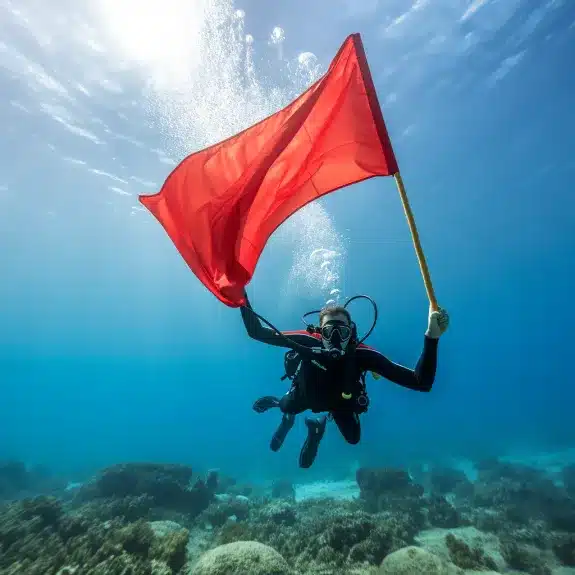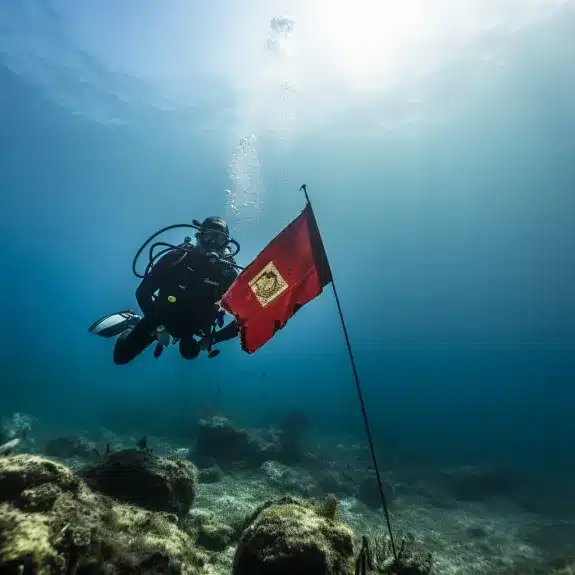As a journalist specializing in diving and water safety, I have encountered numerous incidents that could have been prevented by following proper dive flag regulations. In this article, I will provide you with a comprehensive guide to dive flag regulations in the United States, including the requirements for displaying dive flags and the rules that both divers and boaters must adhere to.
Dive flag regulations are not just arbitrary rules; they exist to ensure the safety of everyone involved in water activities. By understanding and following these regulations, we can prevent accidents and potential harm. So let’s dive into the world of dive flag rules and laws, and equip ourselves with the knowledge necessary to enjoy the underwater wonders responsibly and safely.
Key Takeaways:
- Understanding dive flag regulations is crucial for the safety of divers and boaters.
- Dive flags serve as visual indicators to alert others of the presence of divers and limited mobility of dive boats.
- In the United States, boaters must maintain a safe distance from divers-down warning devices.
- Divers must stay within a certain distance from dive flags or buoys.
- Proper display and sizing of dive flags are essential for maximum visibility.

Importance of Dive Flags for Safety in the Water
Dive flags play a crucial role in ensuring safety in the water for both divers and boaters. These flags serve as visual indicators that communicate the presence of divers below and the restricted movement of dive boats. By displaying dive flags, divers can effectively communicate their position, allowing other vessels to maintain a safe distance and reduce the risk of collisions and accidents.
Furthermore, dive flags act as a universal language understood by divers and boaters worldwide. They serve as a symbol of safety and awareness, promoting responsible diving practices and preventing potential hazards. Whether diving in a local lake or exploring exotic marine environments, the use of dive flags helps foster a culture of safety and respect for all water users.
Underwater flag requirements, scuba diving flag guidelines, and diving safety flag regulations vary by jurisdiction. It is essential for divers and boaters to familiarize themselves with the specific regulations in their area and ensure compliance. By adhering to these regulations and properly displaying dive flags, individuals can contribute to the overall safety of diving activities and minimize risks for all involved.
The Importance of Education and Awareness
In addition to complying with dive flag regulations, it is crucial for divers and boaters to educate themselves about safe diving practices and promote awareness among their peers. This includes understanding the proper use of dive flags, knowing the right of way rules, and being knowledgeable about potential hazards in specific diving areas.
“Education and awareness are key factors in preventing diving accidents. By staying informed and promoting safety practices, we can all contribute to the enjoyment and preservation of our underwater ecosystems.” -Anonymous-
Remember, dive flags are not just a requirement; they are a powerful tool for keeping everyone safe in the water. Whether you are a seasoned diver or a novice, it is essential to prioritize safety and responsibility while exploring the wonders beneath the surface.
References:
- United States Coast Guard. “Navigation Rules – International-Inland.” USCG Navigation Center. Accessed July 15, 2022. https://www.navcen.uscg.gov/?pageName=navRulesContent.
- PADI. “Diving with a Dive Flag.” PADI Blog. Accessed July 15, 2022. https://blog.padi.com/2020/11/30/diving-with-a-dive-flag/.
- Scuba Diving Resource. “Dive Flags and their Use.” Scuba Diving Resource. Accessed July 15, 2022. http://scubadivingresource.com/diveflags.html.
| Dive Flag Size: | At least 20 x 24 inches for vessels |
|---|---|
| Flag Display: | Highest point of the vessel |
| Buoy Flag Size: | At least 12 x 12 inches |
| Flag Display: | Prominently on the water’s surface |
Dive Flag Requirements and Display Guidelines
Divers and boaters must follow dive flag requirements for safety. Understanding and following diving flag display criteria improves communication and prevents mishaps. Boaters in the US must stay 300 feet from divers-down warning systems in open water and 100 feet in rivers, inlets, and navigation channels. When approaching these warning devices, boaters must decelerate to idling speed within the stated distances.
However, divers must stay within 100 feet of a divers-down flag or buoy in rivers, inlets, or navigation channels and 300 feet in open water. Divers must be alert and near the diving flag or buoy. The divers-down flag on a vessel should be 20 by 24 inches and placed at the highest location for visibility. If utilizing a buoy, the flag must be 12 × 12 inches and conspicuously visible on the water.
| Dive Flag Requirements | Display Guidelines |
|---|---|
| Boaters must stay at least 300 feet away in open water and 100 feet away in rivers, inlets, or navigation channels. | The divers-down flag on a vessel must be at least 20 x 24 inches in size and displayed at the highest point of the vessel. |
| Divers must stay within 300 feet in open water and 100 feet in rivers, inlets, or navigation channels. | If using a buoy, the flag must be at least 12 x 12 inches and displayed prominently on the water’s surface. |
It is important to ensure that the dive flag remains fully unfurled and extended, even in the absence of wind or breeze. Flags that are not properly displayed may lead to confusion and compromise safety. Additionally, it is crucial to note that dive flags should not be displayed when divers are out of the water, as this can cause unnecessary confusion among boaters. By following these dive flag requirements and display guidelines, divers and boaters can contribute to a safer and more enjoyable water experience for everyone.
References:
- United States Coast Guard. (n.d.). Boating Safety Regulations. Retrieved from [URL]
- Divers Alert Network. (n.d.). Dive Flag Regulations. Retrieved from [URL]

Conclusion
In conclusion, understanding and adhering to dive flag regulations is of utmost importance to ensure the safety of divers and boaters in the water. By following the requirements for displaying dive flags and abiding by the rules set forth for divers and boaters, we can prevent accidents, collisions, and potential injuries.
Remember, dive flags serve as visual indicators, alerting other water-goers to the presence of divers below and the restricted mobility of dive boats. By displaying dive flags correctly, divers can communicate their position effectively, allowing other vessels to maintain a safe distance. Dive flags are a universal language understood worldwide, promoting safety and awareness in all diving environments.
Always stay informed about the specific dive flag regulations in your area and prioritize safety when exploring the underwater world. By diving with knowledge and adherence to dive flag regulations, we can have a safe and enjoyable experience, while also protecting ourselves and others around us.
FAQ
What are dive flags and why are they important?
Dive flags are visual indicators that alert other water-goers of the presence of divers below and the limited mobility of dive boats. They play a vital role in maintaining safety in the water for both divers and boaters.
What are the requirements for displaying dive flags in the United States?
In the United States, the dive flag on a vessel must be at least 20 x 24 inches in size and displayed at the highest point of the vessel for maximum visibility. If using a buoy, the flag must be at least 12 x 12 inches and displayed prominently on the water’s surface.
How far should boaters stay away from divers-down warning devices?
Boaters must stay at least 300 feet away from divers-down warning devices in open water and 100 feet away in rivers, inlets, or navigation channels. When approaching these warning devices, boaters must slow down to idle speed when within the specified distances.
How close should divers stay to a dive flag or buoy?
Divers must stay within 100 feet of a divers-down flag or buoy within rivers, inlets, or navigation channels and within 300 feet in open water.
When should dive flags be displayed?
Dive flags should only be displayed when divers are in the water. They serve as a visual indicator to alert other water-goers of the presence of divers below.
